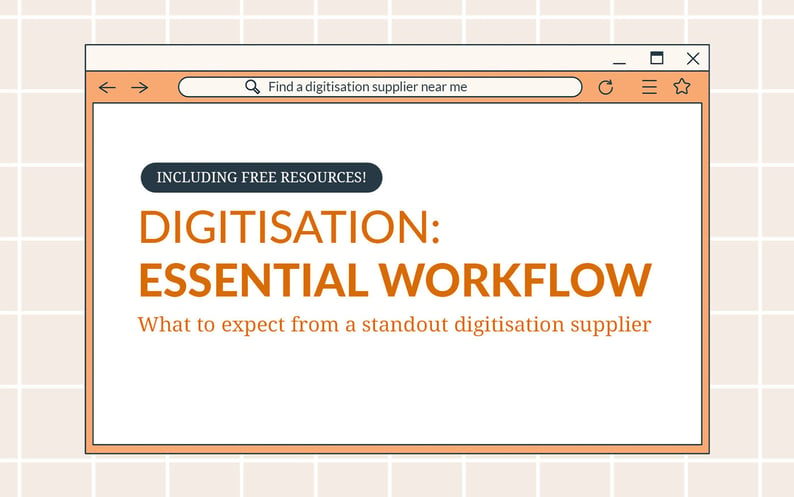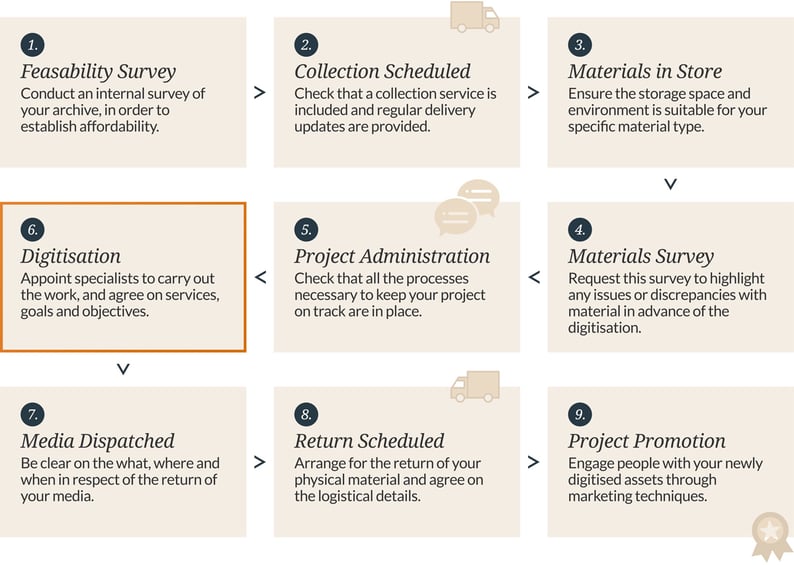
Your collection is a trove of precious materials. These items tell stories of specific times, people, and places, serving to contribute in innumerable ways to the UK’s proud and diverse culture and heritage.
For these reasons it is important to look for a standout digitisation service for the digitisation of your standout physical archive. Getting this partnership right from the outset will reduce the internal pressure on your organisation and guarantee the safety of your material, offering the option for a tailored solution that meets your unique needs and, potentially, saving you costs. We have drawn up a workflow to help you trace the steps that your project will take, from start to finish, suggesting added extras that might be of benefit to you.
Digitisation Workflow: Standout Supplier
A standout supplier will support you throughout your entire digitisation project from scoping your collection, and advising on format flexibility, to identifying opportunities for online discovery and enhanced access. They will ensure the best possible results for your collection, not just keeping to budget, but maximising your funds in every conceivable way.
The following workflow has been created using specialist insight and knowledge to help you establish your expectations and identify a standout digitisation supplier.

The above workflow provides a simple step-by-step approach to the digitisation of your archive and can be used as a road map for the journey that your physical items will take. But what do each of these stages involve, and what else might you like to consider factoring into that standout service that your collection deserves? Read on to find out more.
We've thrown in two FREE resources to help you document and track your journey, keeping your project moving in the right direction. Just complete the form below to get your two FREE resources:
-
Digitisation Essential Workflow Checklist
-
Pre-Digitisation Project Planning Tool
Introducing the NINE main steps to the digitisation workflow:
- Feasibility Survey
- Collection Scheduled
- Materials in Store
- Materials Survey
- Project Administration
- Digitisation
- Media Dispatched
- Return Scheduled
- Promoting your Project
You can use the remainder of this resource to explore each of the digitisation steps in the workflow. Use the bullet points below each overview as a guide to what additional matters you might want to consider, and be sure to ask your provider what more they can offer that will help you to achieve your goals.
1. The feasibility survey
This survey is carried out internally, to establish exactly what your archive consists of, and will help you to identify condition and diversity of material, as well as how extensive your collection is. It will also help you to establish whether you can actually afford to digitise all of it in one go, or whether you will need to complete your project in stages.
Consider discussing with your supplier:
- The feasibility/affordability of your project
- Opportunities for consultation and project scoping
- Budgets, goals and funding opportunities
- The possibility of digitising in phases
- How they can help you to achieve your long term vision
Helpful toolkit of resources:
- Sources of funding guide
- How much does digitisation cost?
- Funding resouce pack
- How to write when you’ve got a need
2. Collection scheduled
Once you have established exactly what is going to be digitised, you need to arrange the collection of your material. You can deliver the items yourself or arrange for an external courier, making sure to track your order and monitor the loading process. Some suppliers will offer a collection and delivery service as part of their digitisation package, so it’s good to check what is included.
Consider discussing with your supplier:
- What’s included in the project costs
- Insurance and security provisions
- Fragile handling and loading processes
- Reassurances that items will be returned in their original order
- Guarantees that items will be returned undamaged
3. Materials in store
Your digitisation provider will need to store your items for the duration of the project and you should be clear about the space that is being provided. This should be adequate for the quantity and type of material you possess, and care and attention should be paid to how they will be placed and organised.
Consider discussing with your supplier:
- Whether it is possible to visit the premises to observe the studio and store
- The fire safety and insurance measures in place
- Security considerations, such as external windows and lockable doors
- Minimising light damage and implementing off-floor storage
- Climate control
4. Materials survey
Once your collection arrives at the appointed digitisation studio it is prudent, for everyone’s sake, that a 'materials survey' is carried out. This will help to identify any issues or discrepancies between what has been received and what was originally quoted, as this could slow the project down and subsequently increase costs. At this stage deadlines and processes can be recalculated, rather than after the project has started.
Consider discussing with your supplier:
- How ‘outliers’ are used to identify potential issues or time-sinks
- How pages are counted for smaller versus larger collections
- The process for comparing observations against the original quote
- How fold-outs, staples, damage, additional work is recorded
- How changes and developments are communicated back
- The assessment of equipment required
Helpful toolkit of resources:
5. Project administration
As an early part of the digitisation process, before digitisation has even begun, it is important to have administration processes in place that will help to drive the project, and the communication around it, in the right direction. Successful digitisation is heavily reliant upon logistics, so you will want to feel confident about how this is managed.
Consider discussing with your supplier:
- Whether example outputs are provided and feedback invited
- Whether a technician ‘issue’ log is kept and updated
- How regular communication is managed
- If a look-up service is provided for records that need to be regularly searched
- Whether they have information, webinars and resources available
- Assignment of a project manager/single point of contact
6. Digitisation
Appointing a specialist digitisation provider, like TownsWeb Archiving, enables you to take a step back and focus on your other roles and responsibilities, safe in the knowledge that your material is being well looked after. However, you want to make sure that you are clear on what is and isn't included, and what process and procedures they will undertake.
Consider discussing with your supplier:
- Your long term goals and how they can help you to meet these
- Their reasons for using a specific methodology for capturing your items
- Output resolution and file formats that will be provided
- Cropping and colour correction that suits your needs
- What additional services they offer and recommend
- Their safe handling procedures and archive standards
- The quality assurance measures in place
- Other organisations you can talk to; you're not alone!
Helpful toolkit of resources:
7. Media dispatched
Once the project has been completed you will no doubt want to gain access to your digital collection as soon as possible. Your data is the first step towards migration, online publishing, and better access and management, as well as supporting any promotional activities you hope to carry out. However, getting your hands on the media is not enough, you want to satisfy some key points too.
Consider discussing with your supplier:
- The second QA process that should be completed internally
- The availability and terms of use for any back-up Cloud service
- How many copies of the data you will be provided with
- Best practice tips for storing your data
Helpful toolkit of resources:
8. Return scheduled
Your project is finally complete and you’ve received your media, but you still don’t have your physical archive. Arrangements need to be made to get this back to the archive store safely, so be sure to check the following things with your provider.
Consider discussing with your supplier:
- The best time for the return of your material, unloading will take time/space
- That your material will be returned in exactly the same condition
- The required organisation of your material will be respected
- Whether you will require assistance with transporting to the store
9. Promoting your project
The completion of your digitisation project is an epic milestone for your physical archive and you will no doubt want to celebrate its digital recreation. It’s time to think about how you are going to reach out to members of the community and other organisations to share your digital assets, and the story of how they came to be digitised.
Consider discussing with your supplier:
- The promotion of your project through their media channels
- Any collaborative pieces you can work on together
- Advice and support in respect of outreach strategies
- Marketing and SEO
- Online access (either through PastView or another platform)
Helpful toolkit of resources:
- How to grow & engage your audience
- Copyright and data protection
- Analytics: Increasing reach of your digital archive
- Online access
- Get inspired: Subscribe to our newsletter
- Get inspired: See how organisations are improving accessibility



 USE OUR ONLINE
USE OUR ONLINE








